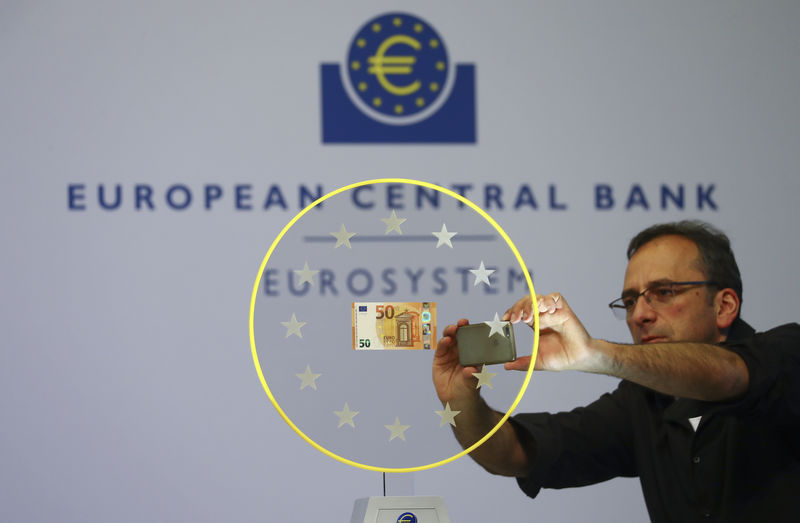(Bloomberg) -- The European Central Bank starts a potentially heated two-day meeting on Wednesday, with officials needing to decide how their newly unveiled monetary strategy affects near-term policy.
After raising their inflation goal to 2% earlier this month and pledging to be “forceful or persistent” to hit it, the challenge for policy makers is to make clear what such an approach means for interest rates and bond-buying. Disagreements immediately surfaced when drafts of potential wording were circulated, Bloomberg reported last week.
President Christine Lagarde heightened the anticipation by promising “interesting variations and changes” to Thursday’s policy announcement and her press conference. She also acknowledged that the unanimity she achieved in the strategy review when it concluded this month will be hard to replicate.
Forward guidance, the language central banks use to describe the future policy path, has become an important tool in times of uncertainty. The aim is to prevent unwelcome market speculation that increases volatility and undermines the economy.
While investors don’t expect the ECB to change either interest rates or the two main asset-purchase programs immediately, they are seeking insight into how the measures, their duration and intensity could shift as the pandemic crisis ebbs.
The central bank, facing a recovery-driven spike in inflation that it insists masks underlying weakness, must convince investors and the public that it’ll neither tighten policy too soon and stymie the recovery, nor let price growth spiral out of control.
Interest Rates
Interest rates -- at record lows, with the deposit rate at -0.5% -- were confirmed in the strategy review as the ECB’s primary tool, and guidance on them is closely linked to progress on inflation. While it will definitely change to reflect the new goal, some economists are looking for more precise signals of persistence.
ABN Amro’s Nick Kounis expects the ECB to indicate that rates will stay at current or lower levels longer than investors currently anticipate. Markets are pricing the first 10 basis-point increase for the end of 2023.
Marchel Alexandrovich of Jefferies (NYSE:JEF) predicts a commitment that borrowing costs won’t rise before 2023. “The ECB should not tolerate any ambiguity about what may happen to interest rates for the next 18-24 months,” he said in a report.
Recent comments from ECB Executive Board member Isabel Schnabel suggest guidance could be linked to actual inflation rather than the central bank’s outlook, according to Gilles Moec of AXA Investment Managers.
Schnabel said in a speech last week that “higher inflation prospects need to be visibly reflected in actual underlying inflation dynamics before they warrant a more fundamental reassessment of the medium-term inflation outlook.”
That could be a hefty clue. She said this month that price growth might need to be “moderately” above target for a “temporary period” -- less than a week before the strategy review was published with almost exactly the same language.
Asset Purchase Program
The ECB’s original Asset Purchase Program has been overshadowed by the 1.85 trillion-euro ($2.2 trillion) Pandemic Emergency Purchase Program. Both use a similar strategy though, buying debt to keep borrowing costs low and ensure the gap between yields in stronger and weaker economies -- the spreads -- don’t widen too much.
Guidance on the APP is relatively vague, so if officials intend to flag that it will become a bigger vehicle for stimulus after the crisis-related tools expire, there’s plenty of room for change.
The most likely option would be to transfer some of the pandemic program’s flexibility to the APP in conjunction with an extension of the ECB’s promise to preserve favorable financing conditions, according to Luigi Speranza and colleagues at BNP Paribas (OTC:BNPQY). That could involve a commitment to step up buying under the older scheme, currently running at 20 billion euros a month, “for at least a pre-defined period or until certain conditions are met.”
The ECB could also rethink the sequence in which it intends eventually to tighten policy. Economists at NatWest Markets including Giovanni Zanni argue that raising interest rates while QE continues could be “sensible and popular.”
“It could appeal across the board,” they said. “There could be a quid pro quo between higher rates, desired by the north, and protection for spreads, desired by the south.”
Pandemic Emergency Purchase Program
PEPP is explicitly temporary -- linked to the current crisis -- so there aren’t many ways to adjust the guidance over the medium term. A straightforward way to signal more support would be to commit to using up the entire 1.85 trillion euros. At the moment, the ECB says “the envelope need not be used in full.”
“Another important point could be clarifying the ECB’s definition of the end of the ‘coronavirus crisis,’” said ING’s Carsten Brzeski. “Is the pandemic over when the euro zone has reached herd immunity, or when the economy has reached its pre-crisis level or when the ECB’s own inflation projections are back to where they were in late-2019?”
Other Tools
The ECB’s policy statement commits to provide “ample liquidity” to banks through regular as well as longer-term lending operations, and to reinvest proceeds from maturing bonds. A more detailed, potentially time-linked, commitment on any or all of those elements could also send a signal on persistent policy support.
One tool the ECB doesn’t have to hand is a pledge to deliberately overshoot its inflation goal to make up for years of under-performance. Such guidance is built into the U.S. Federal Reserve’s policy of average inflation targeting -- a strategy that Lagarde and her colleagues rejected.
“There are no new tools and no make-up strategy akin to the Fed’s flexible average inflation targeting framework, so why is it that we should expect the ECB to better deliver inflation at target under the new strategy?” said Nordea economists Anders Svendsen and Jan von Gerich. “Forceful and persistent forward guidance is the answer!”
©2021 Bloomberg L.P.
